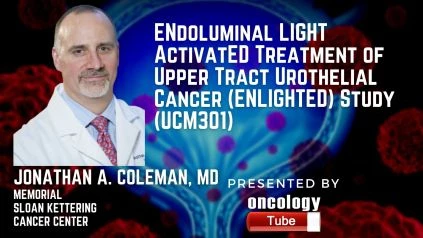Jonathan A. Coleman, MD from Memorial Sloan Kettering Cancer Center speaks about ENdoluminal LIGHT ActivatED Treatment of Upper Tract Urothelial Cancer (ENLIGHTED) Study (UCM301).
Link to Clinical Trials gov:
https://clinicaltrials.gov/ct2/show/NCT04620239
Brief Synopsis:
TOOKAD is being studied in a phase 3 open label, single arm trial for the treatment of Upper Tract Urothelial Carcinoma (UTUC). Patients with low-grade upper tract urothelial carcinoma in the kidney or ureter may be enrolled in the ENLIGHTED trial. The patients will receive TOOKAD (padeliporfin) VTP in two phases: an induction treatment phase and a maintenance treatment process, followed by a 12-month long-term (non-intervention) follow-up phase.
Patients who enroll in the study will receive an induction regimen consisting of 1-3 TOOKAD VTP sessions spaced four weeks (28 +/-3 days) apart. The aim of this induction therapy process is to achieve Complete Response (CR) in the ipsilateral tract system that is involved. Patients will be treated with TOOKAD (padeliporfin) VTP to visually identify tumor locations in the calyces, renal pelvis, and/or ureter during this procedure, and will then be tested endoscopically 28 +/- 3 days later to see if the therapy was effective. If CR is not reached after 28 +/- 3 days, an additional two TOOKAD (padeliporfin) VTP treatments are allowed for a total of three treatments during the induction therapy process. The Primary Response Evaluation (PRE) will take place 28 days +/- 3 days after the last VTP treatment to see whether the treatment was effective in achieving CR, which is characterized as no apparent tumor on endoscopy, negative urinary cytology by instrumented collection, and no indication of tumor on biopsy (if feasible). If the patient does not reach CR after three TOOKAD (padeliporfin) VTP procedures, the procedure will be deemed ineffective and the patient will be removed from the treatment processes. Patients that achieve CR during the induction therapy process of the trial will be able to go on to the maintenance treatment phase. After that, the patients will be monitored for a year to ascertain the length of the response and its safety, as well as to provide scheduled maintenance care.
Maintenance on a regular basis During this time, VTP medications will be given to patients who have signs of tumor recurrence that is treatable according to the following criteria: Low-grade tumors with the largest tumor (index tumor) being between 5 and 15 mm in diameter and occurring in up to two anatomical sites in the calyces, renal pelvis, or ureter (ureter involvement should be in one anatomical location with no more than 20 mm of contiguous ureteral length). Patients who have a treatable tumor recurrence during the Induction Treatment Phase are no longer known to have a ‘full response in the whole ipsilateral kidney,’ and their time to recurrence is tracked.
Patients who complete the study’s 12-month maintenance therapy process, or who drop out after receiving at least one VTP treatment, will be monitored for an additional 12-month non-intervention period to monitor disease-related outcomes and VTP treatment-related adverse events.

